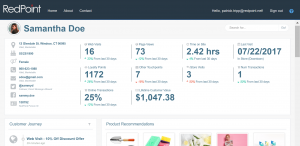What is a Single View Of The Customer?
A single view of the customer, or golden record, collects all that is knowable about a customer into a single point of control that is easily accessible across the organization and used by customer-facing marketers and associates to drive further brand engagement.
The modern customer creates a veritable treasure trove of data through dozens of digital and physical touchpoints, all of which can be actioned to craft more relevant messaging and power more engaging experiences. The problem is that much of this data is split into internal silos based on specific technologies and closely guarded by internal departments.
It’s because of these data silos and fragmented solution portfolio that brands have largely failed to maximize the business value of their customer data. This must change. Brands can ill afford to continue the current state of disconnected data and point solutions. What brands need, and what the Redpoint team and I will showcase at Microsoft Ready in Las Vegas this week, is a solution that can unify disparate consumer data into the single view of the customer that will power contextually relevant experiences regardless of channel.
The Power of a Single View of the Customer
Consumers live a connected, omnichannel life with seamless transitions between digital and physical touchpoints. The same customer who might browse the racks at a retail store could simultaneously be checking competitors’ websites for a better price or searching for coupons on the retailer’s own site. Adding to this environment’s complexity is that consumers expect to have a consistent brand experience across all channels and touchpoints; they also want to be recognized as loyal, repeat customers and gain all the benefits that entails. Native online retailers have already accomplished this goal, and consumers expect that every brand should be able to do the same.
Legacy brands across all industries have failed to create a common brand experience across online and offline engagements. This failure is tied to the lack of a unified view of the customer. Recent CMO Council research bears this out, with only seven percent of brands able to deliver real-time data-driven engagements across online and offline touchpoints. The single view of the customer, also known as a “golden record,” is vital for success in the modern business landscape.
Most brands store customer data in functional and channel-specific silos tied to solutions that don’t share information. Having a single view of the customer means breaking down internal silos and blending anonymous and known data into one composite customer profile that showcases a consumer’s entire interaction history with the brand. Once this customer data is unified, brands can more readily deliver the right interaction at the right time, just like how becoming one with the Force allowed Luke Skywalker to fire the proton torpedoes that destroyed the first Death Star.
Brands may not be fighting a Galactic Empire, but the lack of ability to understand customer behaviors and preferences does have a dramatic impact on revenue. Boston Consulting Group recently found that personalization in retail, healthcare, and financial services will push a revenue shift of $800 billion over the next five years to the 15 percent of companies who get it right. Brands can’t personalize effectively, and capture that revenue bump, if they lack a single view of the customer.
Customer Data Platforms and the Single View
The desire to unify customer data into a central location is not a new one. Legacy data management solutions, such as data warehouses and data lakes, already accomplish this goal for a variety of data types and structures. But it needs to be said that collecting data into a central database is not the same thing as making that data available to business users. A single view of the customer is functionally useless if it can’t be easily accessed by the departments who need it most.

This is where customer data platforms (CDPs) come in. The idea behind a CDP is to maintain an always-on, always-processing customer golden record that is available at low latency throughout the enterprise. CDPs ingest any type of data, regardless of structure, at batch and streaming cadences and unify it into a central point of data visibility and control. The true power of a CDP lies in making this unified data accessible by the solutions and departments that need it most.
What this means from a functional perspective is that business users can access the data they need without making endless requests to the IT team. This enables IT to focus on tasks of greater strategic value to the organization, while also empowering business users to act at the speed of the customer. Because of its ability to unify data regardless of source, type, and cadence, CDPs are a foundational component of an effective omnichannel customer engagement strategy. The prowess of a CDP at connecting customer data also opens the door to effective real-time customer engagement, which is increasingly vital for the modern connected consumer.
Unified Data Leads to Engagement Success
McKinsey recently found that 50 percent of customer interactions now happen during a multi-event, multichannel journey. For most companies, this data is spread among multiple departments and multiple technology silos. This siloed data environment no longer functions as well as it once did; now, brands that can unify customer data will succeed where those who retain internal silos will falter.
CDPs are the technological solution to this problem, enabling brands to craft contextually relevant messaging that reaches consumers in the moment of need through the channel they prefer. Achieving a single view of the customer is an important goal for the modern brand. Customer data platforms achieve that goal and, more than that, enable companies to operationalize their customer data in such a way that they more effectively engage with the connected consumer. Consumers have already moved on to a life with seamless integration between the digital and physical worlds. Brands must follow if they wish to retain their customer base and enhance revenue in the coming years.
